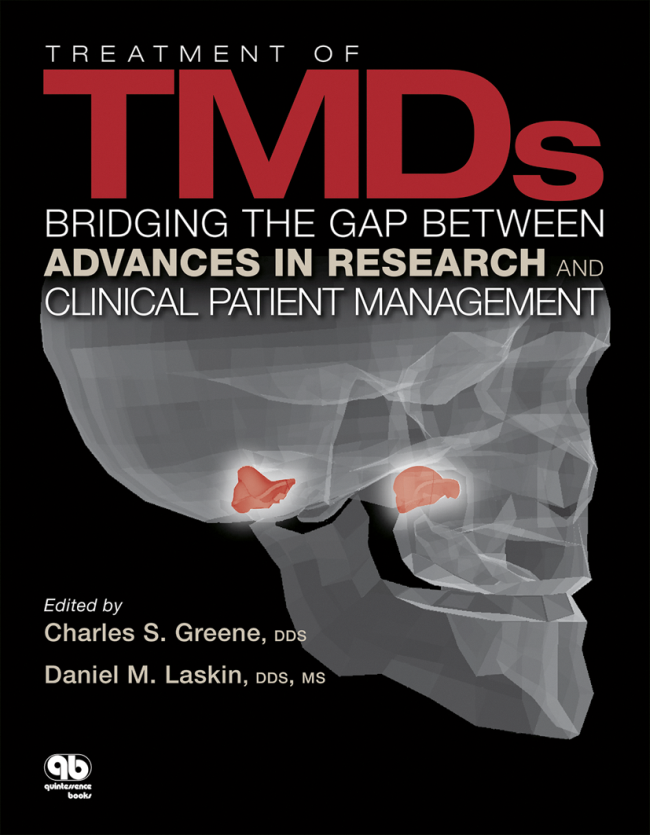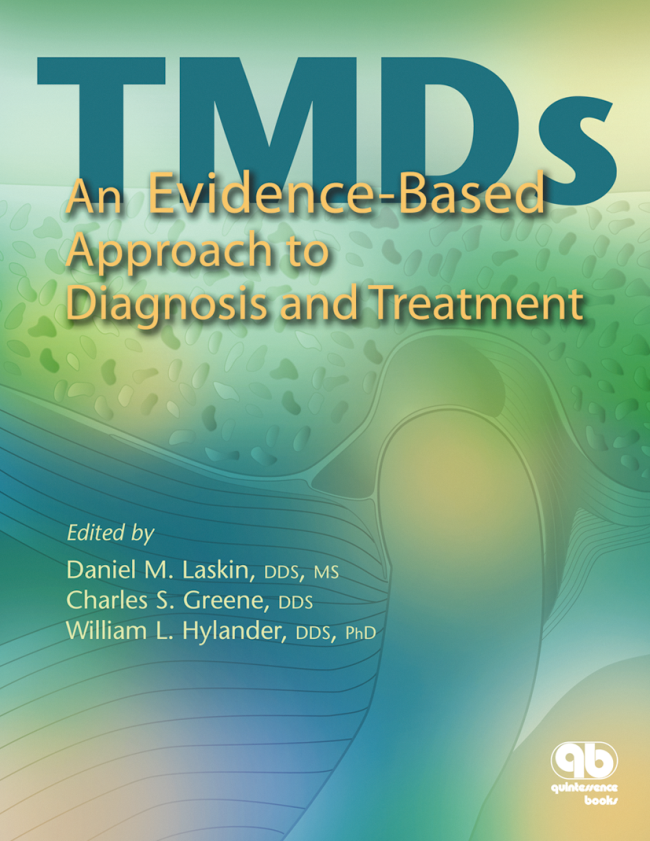Journal of Craniomandibular Function, 2/2024
Reply to letter to the editorSeiten: 180-184, Sprache: Englisch, DeutschTürp, Jens C. / Greene, Charles S.Journal of Craniomandibular Function, 1/2024
Open AccessSeiten: 81-84, Sprache: Englisch, DeutschGreene, Charles S. / Türp, Jens C.Journal of Craniomandibular Function, 1/2024
Open AccessSeiten: 87-91, Sprache: Englisch, DeutschTürp, Jens C. / Greene, Charles S.Journal of Craniomandibular Function, 4/2023
Seiten: 354-360, Sprache: Englisch, DeutschTürp, Jens C. / Greene, Charles S.Quintessence International, 4/2023
DOI: 10.3290/j.qi.b3999673, PubMed-ID: 37039380Seiten: 328-334, Sprache: EnglischKlasser, Gary D. / Abt, Elliot / Weyant, Robert J. / Greene, Charles S.Temporomandibular disorders (TMDs) encompass a number of different musculoskeletal disorders often accompanied by pain and dysfunction. Most TMDs are acute, but can become chronic leading to disability and quality of life issues. There is wide variation in treatment of TMDs, including both conservative/reversible therapies as well as invasive/irreversible treatments, which present difficulties for clinicians, patients, and third-party payers as to what constitutes appropriate care. Data sources: A recent report by the National Academies of Sciences, Engineering, and Medicine highlighted a number of deficiencies, most notably in the education of TMDs within United States of America dental schools at both the predoctoral and postdoctoral (dental) levels as well as addressing the historic inconsistencies in both diagnosis and treatment. New areas for research and interprofessional collaboration should assist in the understanding of TMDs, and updated clinical practice guidelines should help reduce variation in the delivery of evidence-based care. Recently, the American Dental Association recognized orofacial pain as a specialty, which should increase the level and availability of expertise in treating these issues. Summary: Based on the current best evidence, this report is an attempt to alert the profession to discontinue irreversible and invasive therapies for the vast majority of TMDs and recognize that the majority of these disorders are amenable to conservative, reversible interventions.
Schlagwörter: American Dental Association, Commission on Dental Accreditation, dental education and research, National Academies of Sciences, Engineering, and Medicine, temporomandibular disorders
Journal of Craniomandibular Function, 2/2023
Open AccessScienceSeiten: 119-127, Sprache: Englisch, DeutschTürp, Jens C. / Greene, Charles S.Kritische BetrachtungEine vor kurzem in Deutschland durchgeführte Auswertung der Inhalte zahnmedizinischer Webseiten hat gezeigt, dass das sogenannte Phase-1/Phase-2-Konzept zur Behandlung von Patienten mit kraniomandibulären Dysfunktionen (CMD) nach wie vor relativ weit verbreitet ist. Zusammenfassende kritische Fachartikel zu dieser bis in die 1970er-Jahre zurückreichenden Therapiestrategie sind jedoch rar und im zahnärztlichen Schrifttum weit verstreut. Dies erschwert eine wissenschaftsgestützte Einschätzung zu dieser Thematik, zum Beispiel in Zusammenhang mit der Erstellung von Gutachten für Versicherungen oder Gerichte. In diesem Beitrag folgt auf eine kurze Beschreibung dieses therapeutischen Konzepts eine kritische Bewertung desselben. Es wird deutlich, dass diese Strategie keine wissenschaftliche Grundlage hat und ihre weitere Anwendung klinisch und medizinethisch bedenklich ist. Schließlich werden zwei Erklärungen gegeben, warum dessen ungeachtet dieses Zweiphasenkonzept von einigen Zahnärzten immer noch angeboten wird.
Schlagwörter: Myoarthropathien, Unterkiefer, orale Schienen, Malokklusion, zahnärztliche Prothetik, Kieferorthopädie, Überbehandlung, ökonomische Faktoren, zahnärztliche Ethik, evidenzbasierte Zahnmedizin
Quintessence International, 8/2021
DOI: 10.3290/j.qi.b1782267, PubMed-ID: 34282873Seiten: 657-658, Sprache: EnglischGreene, Charles S. / Ohrbach, RichardJournal of Craniomandibular Function, 3/2021
Book ReviewSeiten: 249-254, Sprache: Englisch, DeutschTürp, Jens Christoph / Greene, Charles S. / Kusiak, John W. / Cowley, Terrie / Cowley Jr, Allen W.Journal of Oral & Facial Pain and Headache, 3/2021
DOI: 10.11607/ofph.2021.3.announcementSeiten: 171-172, Sprache: EnglischGreene, Charles S. / Kusiak, John W. / Cowley, Terrie / Cowley Jr, Allen W.NASEM AnnouncementJournal of Oral & Facial Pain and Headache, 3/2020
Seiten: 206-216, Sprache: EnglischGreene, Charles S. / Manfredini, DanieleWithin the orofacial pain discipline, the most common group of afflictions is temporomandibular disorders (TMD). The pathologic and functional disorders included in this condition closely resemble those that are seen in the orthopedic medicine branch of the medical profession, so it would be expected that the same principles of orthopedic diagnosis and treatment are applied. Traditional orthopedic therapy relies on a "Two Pathway" approach involving conservative and/or surgical treatments. However, over the course of the 20th century, some members of the dental community have created another way of approaching these disorders— referred to in this paper as the "Third Pathway"—based on the assumption that signs and symptoms of TMD are due to a "bad" relationship between the mandible and skull, leading to a variety of irreversible occlusal or surgical corrective treatments. Since no other human joint is discussed in these terms within the orthopedic medicine communities, it has become progressively clear that the Third Pathway is a unique and artificial conceptual creation of the dental profession. However, many clinical studies have utilized the medically oriented conservative/ surgical Two-Pathway model to diagnose and treat TMD within a biopsychosocial model of pain. These studies have shown that TMD comprise another domain of orthopedic illness that requires a medically oriented approach for good outcomes while avoiding the irreversible aspects of the Third Pathway. This review presents historical and current evidence that the Third Pathway is an example of unorthodox medicine that leads to unnecessary overtreatment and further proposes that it is time to abandon this approach as we move forward in the TMD field.
Schlagwörter: dental occlusion, jaw repositioning, orthopedics, temporomandibular disorders, TMD






